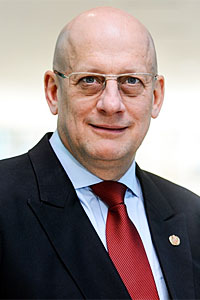
On World Aids Day, Asia and the Pacific can celebrate immense achievements. Some 2.1 million people now have access to lifesaving medicines -- more than ever before. This means that mothers living with HIV like Anya from a small fishing village in central Thailand can watch their children grow into resilient adults. And Thuya has the hearty strength to sell flowers and support his family in Yangon, Myanmar.
Treatment is bringing big benefits to so many families and communities.
The number of people on antiretroviral medicine (ARV) in the region has doubled between 2010 and 2015. If these efforts are sustained and increased, the region will be on track to reach the global target of ensuring 90% of people who know their HIV positive status access ARVs by 2020. Success in treatment is translating into results for the elimination of mother-to-child transmission.
Thailand has one of the highest treatment coverage for the region and this year became the first country in Asia to be officially certified for stopping HIV infections in babies.
Despite these significant strides forward, there are threats. After falling steeply for years, new HIV infections have flat lined in the past five years in Asia and the Pacific. In some key populations including people who inject drugs and men who have sex with men they are rising rapidly.
In Thailand last year, 51% of new HIV infections were among men who have sex with men. There are troubling signs that an increasingly younger group of gay men are becoming vulnerable to the virus. Data published in 2015 shows that in Bangkok, HIV incidence among men who have sex with men aged 18-21 was 9% -- more than double that of the over 30 age bracket. This trend is also seen in the Philippines and other countries in the region.
Young gay men are at higher risk of HIV because like many of their heterosexual peers, they are starting to have sex earlier with multiple partners. Sexuality education is still inadequate as surveys show that only one quarter of eleventh graders in Thailand had comprehensive knowledge of HIV. Drug and alcohol use is also rising among young people and that can increase the risk of HIV.
However, young gay men have particular factors which can make HIV a bigger threat than for their heterosexual peers. Homophobia, bullying, family disapproval, social isolation, depression and violence can overshadow their lives. Together with self-stigmatisation this has serious repercussions on the physical and mental health of young gay men and impairs their ability to make healthy choices and seek appropriate services. Compared to their older counterparts, fewer young gay men are accessing condoms and HIV testing.
Mobile apps have also made finding sexual partners easier. Behavioural surveys have found that 80% of men who have sex with men in 35 cities in the Philippines were members of social networking sites and nearly 40% had found sex partners through the sites.
To stop new infections in young gay men we need to revamp dangerously out-of-date HIV efforts and respond to their particular needs.
We must go beyond biology lessons to provide comprehensive sexuality education, create friendlier and less stigmatising health services with community-led and self-testing programmes and provide not only condoms and lubricants but also pre-exposure prophylaxis. These innovations already have a proven record and must become the gold standard for national programmes.
New channels for reaching young people on their own turf will make or break our efforts. Social networking HIV outreach initiatives by gay social apps like Hornet are bringing HIV information to millions of young users. These efforts must expand.
Since the early days of the Aids epidemic, Thailand has been behind some of the most innovative strategies such as the 100% condom use programme with sex workers and has adapted to the evolving epidemic at every turn. The latest threat is no different.
Already, the country has one of the most progressive policies on access to HIV services for young people. While most countries enforce 18 as the age of consent, Thailand has introduced a policy to enable adolescents to independently obtain an HIV test. The country was also one of the first in Asia to offer PrEP, daily medicine that can reduce chance of getting HIV, at low cost to gay men with high-risk behaviour in Bangkok. The innovative Adam's Love, an internet and social media-based HIV outreach initiative engaging men who have sex with men has also reported success and is expanding into other countries.
As Thailand scales up these innovations and related services, the country must once again outwit the virus and lead the region in protecting the health of gay men at the very start of their adult lives.
Steve Kraus, director of the UNAids Regional Support Team for Asia and the Pacific.
